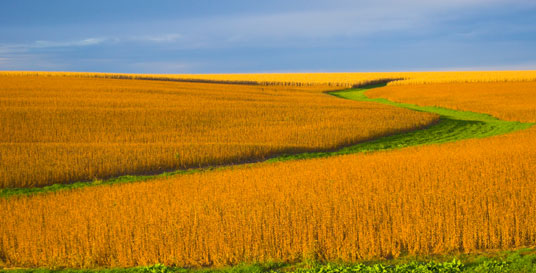
Agricultural News
Research Paper Shows No Link Between Biofuel Production and Change in Land Usage
Tue, 17 May 2011 16:51:38 CDT
 Based on what they describe as a "'bottom-up', data-driven, statistical approach," researchers at Michigan State University have concluded that biofuel production in the United States through 2007 "probably has not induced any indirect land use change." The research, conducted by MSU scientists Seungdo Kim and Bruce Dale, is discussed in a paper that will be published in the next issue of the journal Biomass and Bioenergy . The paper was made available online May 13 for a fee.
Based on what they describe as a "'bottom-up', data-driven, statistical approach," researchers at Michigan State University have concluded that biofuel production in the United States through 2007 "probably has not induced any indirect land use change." The research, conducted by MSU scientists Seungdo Kim and Bruce Dale, is discussed in a paper that will be published in the next issue of the journal Biomass and Bioenergy . The paper was made available online May 13 for a fee.
The researchers empirically tested whether indirect land use change (ILUC) occurred through 2007 as the result of U.S. biofuels expansion by using historical data on U.S. croplands, commodity grain exports to specific regions and land use trends in those geographical regions a previously unused but commonsense approach to verify what, if any, scientific evidence supports the ILUC theory. ILUC is the theory that any acre used in the production of feedstocks for biofuels in the U.S. necessarily results in a new acres coming into food or feed production somewhere else in the world.
"Biofuel production in the United States up through the end of 2007 in all probability has not induced indirect land use change," the authors wrote. "There are two feasible dependent conclusions that might be drawn from this interpretation: 1) crop intensification may have absorbed the effects of expanding US biofuel production or 2) the effects of US biofuel production expansion may be simply negligible, and not resolvable within the accuracy of the data."
"Solving America's energy crisis must rely on the best available science. Since its inception, the notion indirect land use change has been deeply flawed and repeatedly disputed. It is refreshing to see academia using real-world data and actual market behaviors to challenge the hypothetical results and 'what if' scenarios that have so far dominated the ILUC discussion," said Renewable Fuels Association President and CEO Bob Dinneen. "Biofuels like ethanol offered unparalleled environmental benefits as a renewable alternative to gasoline. Hiding behind the faux science of ILUC, some have attempted to stall and thwart the sustainable growth of biofuels across the globe and especially in the U.S. This work from MSU, coming on the heels of other recent scientific analyses, has demonstrated that ILUC as a matter of science and fact is wrong."
This Michigan State University research arrives at a similar conclusion as recent work done by the U.S. Department of Energy's Oak Ridge National Laboratory (ORNL). Scientists at Oak Ridge concluded that ILUC resulting from corn ethanol expansion over the past decade has likely been "minimal to zero."
The Michigan State study relied on real world data that looked at acreage, production and trade data from the past two decades during a time of unprecedented growth in U.S. ethanol production. This is a stark difference between work done by and for the California Air Resources Board (ARB) and the U.S. Environmental Protection Agency (EPA). Both CARB and EPA utilized assumption-driven future scenarios and highly uncertain economic modeling tools to develop point estimate ILUC penalties for biofuels that are enforceable by law. As Kim and Dale note in their analysis, "Prior iLUC studies have failed to compare their predictions to past global historical data."
The report's bottom line about U.S. cropland is clear: "No arable land increases from the 1990s are observed in the United States. Furthermore, no declines in natural ecosystem lands in the United States have been observed since 1998." Similarly, the analysis suggests cropland expansion in foreign countries is not well correlated to U.S. biofuels demand for certain feedstocks.
Last week, the RFA released a report on the importance the livestock feed co-product of ethanol production. The report noted that the growing availability of this ethanol feed is offsetting the need for additional crop acres.
Click here for the full report on the role of the US Ethanol Industry in Food and Feed Production
WebReadyTM Powered by WireReady® NSI
Top Agricultural News
More Headlines...



















